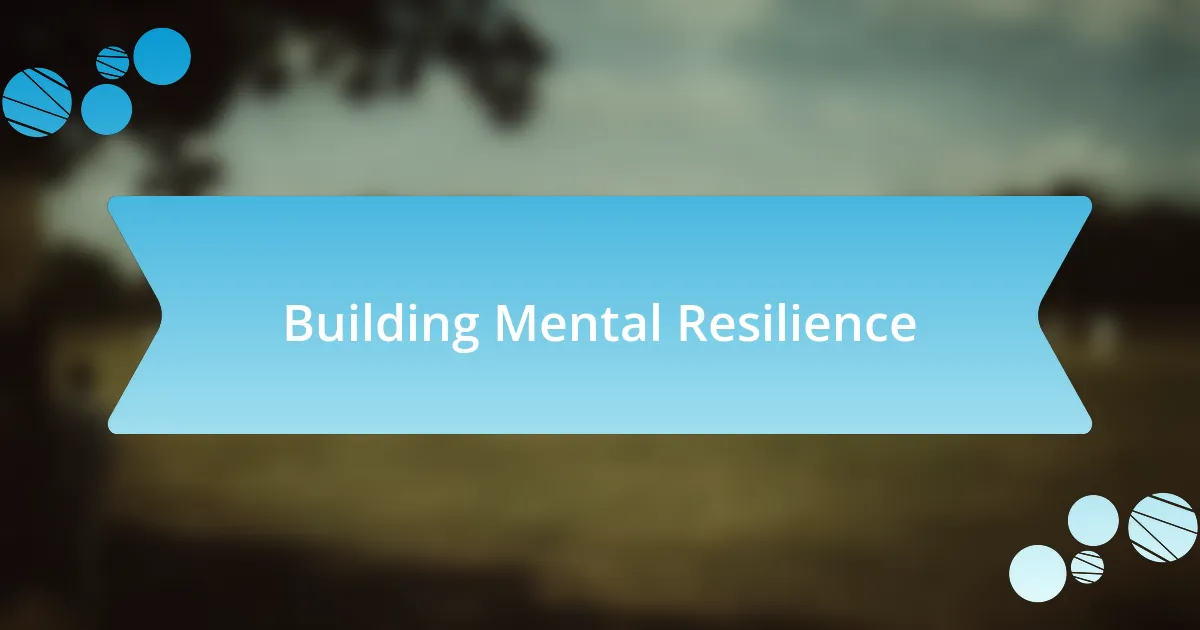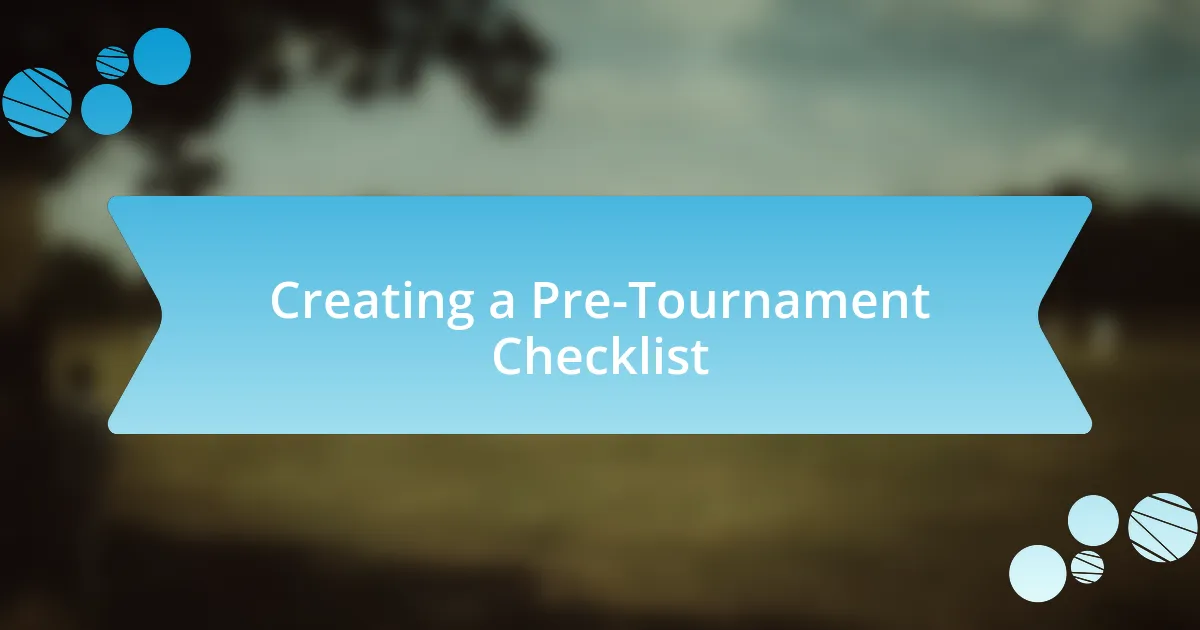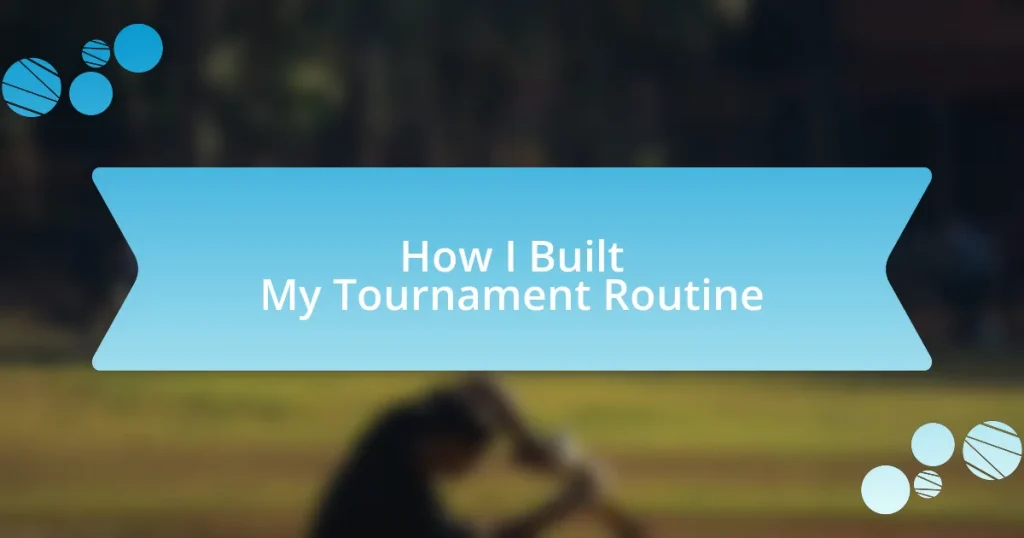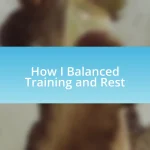Key takeaways:
- Defining goals requires introspection, actionable steps, and regular reassessment to align with evolving aspirations.
- Crafting a training plan should include skill development, physical conditioning, mental training, and recovery.
- Nutritional balance and hydration are essential for optimal athletic performance, impacting energy levels and focus during competitions.
- Post-tournament reviews are crucial for learning, refining strategies, and fostering a supportive environment among peers.

How to Define Your Goals
Defining your goals starts with introspection. I remember sitting down with a notebook, questioning what success truly meant to me. Was it about winning every tournament, or was it about improving my skills week by week? This moment of reflection helped me crystallize my objectives.
Once you’ve identified what you want, it’s crucial to break down those broad goals into specific, actionable steps. When I aimed to increase my performance under pressure, I didn’t just say, “I want to be calmer.” Instead, I created weekly practices that focused heavily on mindfulness techniques, creating an achievable path instead of an overwhelming mountain to climb. What small step can you take today to move closer to your goal?
Lastly, don’t forget to revisit and adjust your goals as you grow. I’ve often found that some goals become less relevant as my skills evolve. Are your goals still aligned with your current abilities and aspirations? Reflecting on this regularly keeps your journey dynamic and focused, ensuring you’re always moving in the right direction.

Crafting Your Training Plan
Crafting a training plan is where the magic begins. I remember the first time I put together a structured routine. It felt like piecing together a puzzle, trying to find the perfect combination of drills and mental exercises. I learned that every athlete’s needs are unique, so my plan needed to reflect my strengths and weaknesses.
Consider including these elements in your training plan:
– Skill Development: Focus specific sessions on improving techniques and strategies.
– Physical Conditioning: Incorporate exercises that build strength, endurance, and flexibility.
– Mental Training: Dedicate time to visualization and mindfulness practices.
– Recovery: Schedule rest days and activities such as stretching or meditation that allow your body to heal.
– Self-Assessment: Regularly evaluate your progress and adjust your plan accordingly.
Sharing my journey with others made the process even more enriching. Collaborating with fellow athletes opened my eyes to new ideas that I hadn’t considered before, reminding me that inspiration can come from many sources.

Building Mental Resilience
Building mental resilience is a crucial aspect of any athlete’s journey. I can recall times on the competition floor when self-doubt crept in, and it was the mental training that kept me grounded. Developing a strong mindset isn’t just about positive thinking; it’s about facing challenges head-on and learning from them.
One technique that truly helped me was maintaining a journal to reflect on my experiences. Writing down my thoughts after each training session allowed me to process both successes and setbacks. This practice not only cleared my mind but also strengthened my belief in my ability to adapt and improve.
Another powerful method I discovered was visualization. Before competitions, I would spend time picturing myself succeeding, from my warm-up routine to execution during the event. This mental rehearsal not only calmed my nerves but also ingrained a sense of familiarity, leading me to perform better when it truly mattered.
| Technique | Description |
|---|---|
| Journaling | A reflective practice that helps to process experiences and solidify learning. |
| Visualization | Mental rehearsal of events that boosts confidence and prepares the mind for actual performance. |

Nutrition for Optimal Performance
Nutrition plays a fundamental role in ensuring optimal performance during tournaments. I remember a time when I underestimated the impact of proper fueling, and it cost me dearly on the competition floor. Have you ever felt sluggish halfway through a match? That feeling can often stem from inadequate nutrition before competing, making it vital to pay attention to what you eat leading up to an event.
A balanced diet, rich in carbohydrates, proteins, and healthy fats, is essential for maintaining energy levels. I learned to prioritize meals that not only satisfied my hunger but also provided sustained energy. For instance, incorporating complex carbohydrates like quinoa or sweet potatoes before competition days gave me the stamina to push through even the longest matches. Have you tried experimenting with different foods to see what works best for your body?
Hydration is another critical aspect that should never be overlooked. I often found myself reminding teammates to stay hydrated, especially during high-stakes periods. I recall a tournament where I didn’t drink enough water, and by the time the finals rolled around, I felt dehydrated and fatigued. It’s a simple aspect, but ensuring you’re well-hydrated can significantly enhance your focus and agility when it matters most.

Creating a Pre-Tournament Checklist
Creating a pre-tournament checklist is crucial for ensuring that nothing slips through the cracks when you’re preparing to compete. I’ve learned the hard way that a simple oversight, like forgetting my gear bag or vital documents, can lead to last-minute panic. Have you ever experienced that feeling of dread when you realize something is missing just before your match?
I began crafting my checklist by listing all essentials — from competition gear and personal items to nutrition and hydration supplies. One time, I settled into a routine with my checklist, only to realize two hours before my fight that I’d forgotten my mouthguard! Since then, I’ve made it a habit to go through my list multiple times leading up to the tournament, ensuring that everything is in order. It’s incredible how something so simple can provide a sense of control and calm amidst the pre-tournament jitters.
Additionally, I started including mental preparation items on my checklist, such as reviewing my game plan and visualizing my performance. I can’t stress how beneficial this has been; it helps me to focus and build confidence. Have you considered what mental tactics empower you before a big event? Incorporating these elements into my routine has transformed my approach, allowing me to step onto the competition floor with a clear mind and purposeful strategy.

Establishing a Post-Tournament Review
Establishing a post-tournament review is something I never overlooked after a few tournaments where I felt a lingering sense of uncertainty about my performance. I typically sit down with my notes right after the event, reflecting not just on the outcomes but also on the entire experience. This practice allows me to pinpoint what went well and where I can improve, almost like giving myself a scorecard for my overall growth.
After my last tournament, I noticed that while my technical skills had improved, my mental focus fluctuated during critical moments. I remember feeling frustrated watching my video footage, realizing I could have executed a key strategy better. This reflection prompted me to write down my thoughts and feelings immediately after the event. It wasn’t just about the results but understanding the emotions that affected my performance, reinforcing the importance of mental resilience in future competitions.
Moreover, I’ve found it helpful to share my insights with a few trusted fellow competitors. Discussing our performances and strategies has not only deepened my understanding of the sport but also created a supportive environment where we can learn from each other. Have you ever swapped notes with a peer after a tough match? This collaborative approach has been invaluable in shaping a more comprehensive post-tournament review, allowing me to refine my techniques and boost my confidence for the next challenge.

Adjusting Your Routine for Improvement
Adjusting a routine for improvement requires a willingness to experiment and adapt based on what you’ve learned from your post-tournament reviews. After my earlier experiences, I decided to incorporate more focused mental exercises into my routine. For example, I would spend 10 minutes each day visualizing my performance in high-pressure situations, which ultimately helped me regain confidence during critical moments in competition.
One evening, feeling particularly frustrated after missing a few key shots during practice, I realized I needed a change. I adjusted my warm-up routine to include specific drills that targeted my weaknesses rather than just going through the motions. This not only made my practice more engaging but also yielded noticeable improvements in my performance during tournaments. Have you ever felt stuck in a routine? Finding that spark of creativity can be essential to breaking through barriers.
Moreover, I’ve learned that even the smallest tweaks can lead to significant improvements. Instead of sticking solely to my old stretching routine, I now incorporate mobility exercises that help with my range of motion. This shift has made a tangible difference in my agility during matches. It’s fascinating how listening to your body can lead to such growth, don’t you think? Adjusting your routine isn’t just about physical skills; it’s about evolving mentally and emotionally, too.















